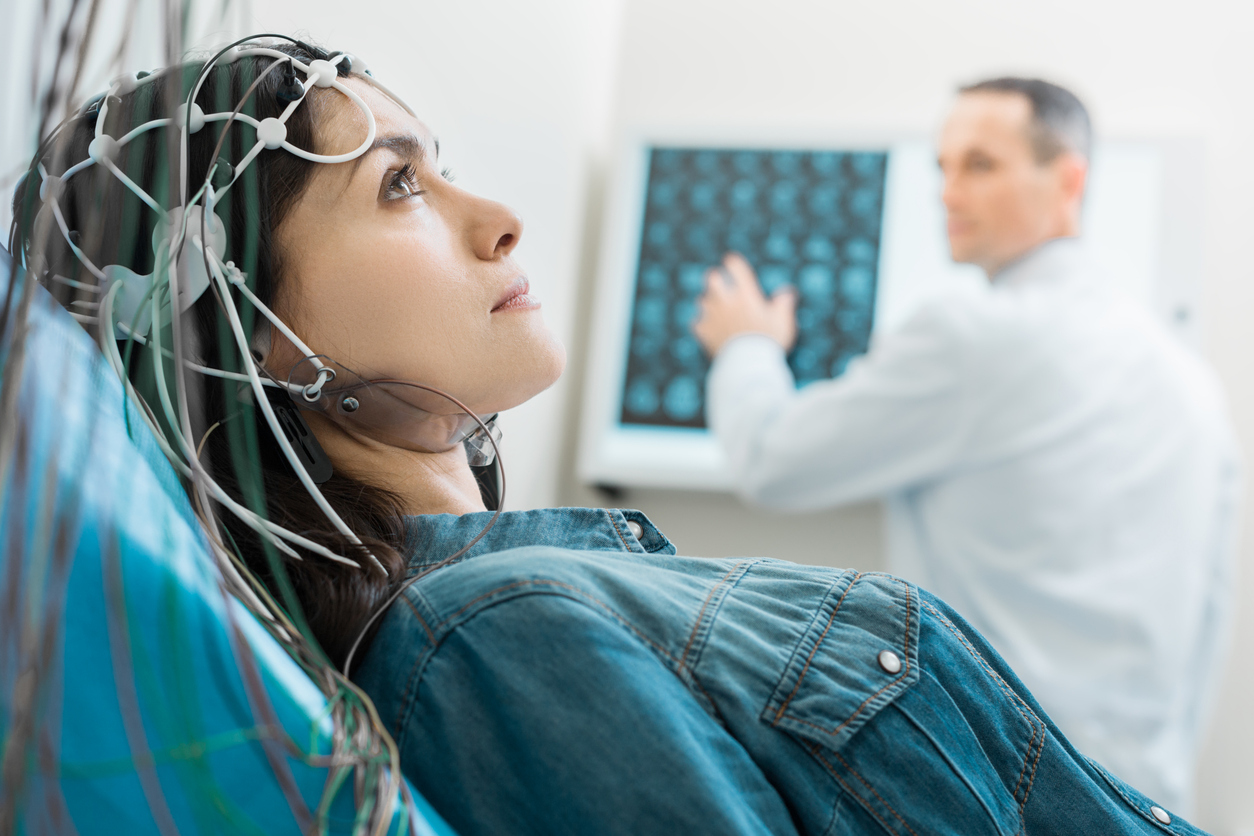What do you think of this article?
By Dr. David Woo - November 18, 2024

Neurofeedback therapy is an innovative, non-invasive treatment that uses real-time monitoring of brain activity to train individuals to regulate their brainwave patterns. By providing feedback through visual or auditory cues, neurofeedback therapy aims to help manage various mental health conditions such as depression, anxiety, attention-deficit hyperactivity disorder (ADHD), post-traumatic stress disorder (PTSD), and more. This therapy is based on the principle of brain plasticity—that the brain can be encouraged to “rewire” itself for healthier functionality.
Jump to
- How Does Neurofeedback Work?
- Types Of Cues Used In Neurofeedback
- Effectiveness Of Neurofeedback
- Issues With Neurofeedback
- Neurofeedback Alternatives
- Neurofeedback vs. TMS vs. Medications
- Mental Health Treatment In NYC
How Does Neurofeedback Work?
Neurofeedback therapy works by using sensors to monitor brainwave activity in real time and images, sounds, or touch to change the patient’s brainwaves. During the therapy, the patients are supposed to learn what kinds of stimulations and associations improve their mental health. The aim is to give the patient the mental tools they need to self-manage and overcome their symptoms.
The neurofeedback therapy process, step-by-step:
- Electroencephalogram (EEG) monitoring: Small sensors are placed on the scalp to measure brainwave activity.
- Real-time feedback: Participants watch visualizations or listen to sounds that change according to their brain activity.
- Training the brain: By adjusting brainwave patterns through feedback, individuals learn to self-regulate symptoms related to mental health conditions.
Types Of Cues Used In Neurofeedback
Neurofeedback therapy utilizes a variety of cues, such as visual, auditory, or tactile feedback, to train the brain. For example:
- Visual cues: Participants may watch a video or animation that changes speed or clarity based on their brainwaves. If the desired brain activity is achieved, the image may become clearer, encouraging the brain to maintain that state.
- Auditory cues: Tones or music may be played that vary in volume or pitch in response to brainwave changes. This can help train the brain to regulate focus or reduce anxiety.
- Tactile cues: In some cases, vibrations or gentle taps may be used as feedback, particularly for individuals who are more responsive to touch than sound or visuals.
These cues are essential because they provide immediate, real-time feedback to the brain, helping the individual understand when they are achieving the targeted brainwave state. Over time, this consistent reinforcement strengthens neural pathways, making the therapy more effective.
Effectiveness Of Neurofeedback Therapy
Recent studies indicate that neurofeedback therapy can lead to significant improvements in certain mental health conditions, such as the following:
Conditions Treated With Neurofeedback
- ADHD: Studies have indicated that neurofeedback therapy could significantly improve attention and impulse control in children with ADHD (1,2).
- Depression and anxiety: Neurofeedback therapy has been shown to help normalize brainwave patterns associated with these mood disorders, leading to a reduction in symptoms (3,4).
- PTSD: A 2024 meta-analysis showed neurofeedback therapy reduced PTSD symptoms and improved emotional regulation (5).
Neurofeedback is also being explored for various other brain-related disorders and endeavors, including obsessive-compulsive disorder (OCD), bipolar disorder, schizophrenia, dyslexia, and even cognitive enhancement.
Issues With Neurofeedback Therapy
It’s easy to understand the appeal of neurofeedback therapy. It’s a non-invasive, drug-free treatment that appears to have potential for a wide range of conditions. However, “potential” is a key operating word here.
Neurofeedback therapy is still being researched for various applications. Scientific reviews of the current research have been critical and cautious, noting that current findings are “very preliminary, and no strict conclusions can be drawn at this time” (6).
Neurofeedback research still requires greater standardization and rigor in its methodology before this particular therapy can be widely recommended. However, there are alternatives out there with a proven track record.
Neurofeedback Therapy Alternatives
Medications
Pharmaceutical medications such as antidepressants are usually the first-line treatment for mood disorders. They can easily be administered at home and are effective for many, but they can also have undesirable side effects. This is why a medication regimen should also be accompanied by regular check-ins with a psychiatric professional to monitor effectiveness, manage any side effects, and prescribe new treatments if need be.
Madison Avenue TMS & Psychiatry provides medication management services for individuals in the NYC area taking psychiatric medications. These telehealth consultations allow for the ongoing evaluation of your medications’ effectiveness, with adjustments to the type or dosage to ensure optimal treatment results.
Transcranial Magnetic Stimulation (TMS)
TMS is a non-invasive therapy that uses magnetic pulses to stimulate brain cells delivered through a helmet-like device in a clinical setting.
Like neurofeedback therapy, TMS works by acting on brain plasticity. However, unlike neurofeedback therapy, TMS directly activates the brain’s electrochemical system instead of relying on the patient to train themselves, making it more reliable. TMS can be more precisely targeted than neurofeedback. For example, your doctor can direct the pulses to activate the dorsolateral prefrontal cortex, a brain region related explicitly to mood regulation, to alleviate symptoms of depression.
TMS is FDA-approved for treating depression, OCD, and anxious depression. It has also been shown to be effective for other conditions without causing the systemic side effects typically associated with pharmaceuticals. TMS is safe and well-tolerated; most patients report zero or mild side effects (e.g., a slight headache or temporary scalp irritation).
Neurofeedback vs. TMS vs. Medications
| Feature | Neurofeedback Therapy | TMS | Medications |
|---|---|---|---|
| How they work | Trains the brain to self-regulate using real-time EEG feedback | Uses magnetic pulses to stimulate nerve cells in targeted areas | Alters brain chemistry to balance neurotransmitters |
| Conditions treated | ADHD, depression, anxiety, PTSD, researched for other disorders | Depression, anxiety, OCD, PTSD, bipolar disorder, borderline personality disorder (BPD) | Depression, anxiety, bipolar disorder, ADHD, and related disorders |
| Invasiveness | Non-invasive | Non-invasive | Systemic (affects the whole body) |
| Side effects | Minimal (e.g., temporary fatigue) | Headaches, minor scalp discomfort, small (<1%) chance of seizure | Nausea, weight gain, sexual dysfunction |
| Treatment duration | Weekly sessions over several months | Daily sessions for 4-6 weeks | Daily dosing |
| Duration of effects | Long-lasting with continued training | Long-term benefits after a few weeks of daily sessions, may need an occasional “top-up” session | More dependent on ongoing use |
| Insurance coverage | No | Yes. Learn more about insurance coverage for TMS | Yes |
Mental Health Treatment In NYC
At Madison Avenue TMS & Psychiatry, we provide comprehensive mental health services tailored to meet individual needs in the New York City area. Our offerings include medication management and TMS therapy, and we are dedicated to ensuring that every patient receives personalized therapy using the most effective treatment for them.
If you or a loved one are exploring options for managing mental health conditions, our team is here to guide you in finding the right therapy for your unique situation. Contact us online today or call (212) 731-2033 to learn more about medications or TMS and take the first step toward a healthier mind and happier life.
Learn more about brain stimulation therapies
Sources:
- Moradi, N., Rajabi, S., & Mansouri Nejad, A. The effect of neurofeedback training combined with computer cognitive games on the time perception, attention, and working memory in children with ADHD. Applied Neuropsychology: Child. 2022;13(1), 24–36. Link. Accessed October 20, 2024.
- Shojaei, Behnaz MSca; Naeim, Mahdi MScb; Kazemi, Zahra MScb; Taheri, Mostafa MScc; Imannezhad, Shima MDd; Mohammadi, Yasaman DDSe. Reducing symptoms of attention-deficit/hyperactivity disorder (ADHD) in elementary students: the effectiveness of neurofeedback. Annals of Medicine & Surgery. 2024;86(5):p 2651-2656. Link. Accessed October 20, 2024.
- Xia, Z., Yang, P., Chen, S., Zhou, H., & Yan, C. Uncovering the power of neurofeedback: A meta-analysis of its effectiveness in treating major depressive disorders. Cerebral Cortex. 2024;34(6). Link. Accessed October 20, 2024.
- Duke, G., Yotter, C., Sharifian, B.; Duke, G., Petersen, S. The effectiveness of microcurrent neurofeedback on depression, anxiety, post-traumatic stress disorder, and quality of life. Journal of the American Association of Nurse Practitioners. 2024;36(2):p 100-109. Link. Accessed October 20, 2024.
- Voigt, J. D., Mosier, M., & Tendler, A. Systematic review and meta-analysis of neurofeedback and its effect on posttraumatic stress disorder. Frontiers in Psychiatry. 2024;15, 1323485. Link. Accessed October 20, 2024.
- Babaskina L, Afanasyeva N, Semyonkina M, Myasnyankina O, Sushko N. Effectiveness of Neurofeedback Training for Patients with Personality Disorders: A Systematic Review. Iran J Psychiatry. 2023 Jul;18(3):352-361. Link. Accessed October 20, 2024.
Dr. David Woo is the owner and head clinical psychiatrist at Madison Avenue TMS and Therapy in New York City. Dr. Woo has been seeing patients in private practice since 2002, always with the goals of combining evidence-based medicine with psychodynamic psychotherapy and collaborating with other mental health professionals to ensure the best possible outcomes for his patients. He has been certified to administer TMS at his practice since 2017. His greatest clinical interests include helping patients suffering from depression, anxiety, and obsessive compulsive disorder.
Follow Dr. Woo On









